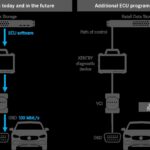Converting a 38-pin connector to the standard OBD2 interface opens up a world of diagnostic possibilities for older vehicles. This article explores the reasons for this conversion and the benefits it offers.
Many older European vehicles, particularly those manufactured before the widespread adoption of OBD2 in the mid-1990s, utilize a 38-pin diagnostic connector. While functional for their time, these legacy systems lack the standardization and advanced capabilities of OBD2. Connecting a 38-pin equipped car to a modern OBD2 scanner requires an adapter – essentially a 38 Pin To Obd2 cable. This adapter bridges the communication gap, translating the signals from the vehicle’s older system into a format understood by current diagnostic tools.
A key advantage of using a 38 pin to obd2 adapter is access to a broader range of diagnostic software and hardware. OBD2 scanners are readily available and offer comprehensive features like reading and clearing fault codes, viewing live data streams, performing actuator tests, and accessing vehicle-specific information. This allows mechanics and car enthusiasts to troubleshoot issues more effectively and perform more in-depth analysis of vehicle performance.
Moreover, the standardized nature of OBD2 simplifies the diagnostic process. Unlike the various proprietary 38-pin systems used by different manufacturers, OBD2 ensures compatibility across a vast range of vehicles. This eliminates the need for multiple specialized tools and streamlines the troubleshooting workflow. A single OBD2 scanner, coupled with the appropriate 38 pin to obd2 connector, can effectively diagnose a wide array of older European cars.
Converting to OBD2 also unlocks the potential for using advanced diagnostic software. Many modern programs offer features like data logging, graphing, and customizability, providing a deeper insight into vehicle behavior. These capabilities are often unavailable with older 38-pin diagnostic tools.
Finally, the cost-effectiveness of 38 pin to obd2 adapters makes them an attractive option for owners of older European vehicles. Adapters are generally more affordable than purchasing specialized diagnostic equipment for each specific 38-pin system. This accessibility empowers individuals to perform their own diagnostics and maintenance, saving on potentially expensive trips to a mechanic.
In conclusion, converting from a 38-pin connector to OBD2 offers significant advantages in terms of diagnostic capabilities, standardization, access to advanced software, and cost-effectiveness. This simple conversion can breathe new diagnostic life into older vehicles, making them more manageable and enjoyable to own.
